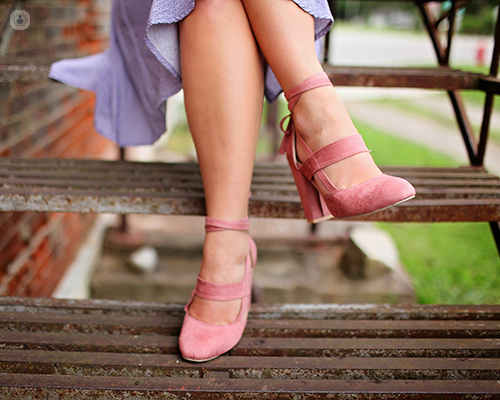An expert's guide to spider veins
Autore:Spider veins are a common condition that mostly affects women. Many people undergo treatment for cosmetic reasons, but they can also be a sign of something more serious. In his latest article, renowned vascular surgeon Mr Giuseppe Serpieri offers his expert insight into this condition.

What are spider veins, and why and how do they appear?
Spider veins are unsightly, usually tiny veins that can appear on the lower limbs or other areas of the body, for example, the face or the nose. They can be a light red colour or sometimes blue or purple, depending on the amount of oxygen inside the veins. They are more common in women, and are more prone to appear if there is a family history of spider veins. More than 80% of the patients who come to see me with spider veins are female.
They may also be related to pregnancy, if you stand for long periods during your working day, or if you are overweight or obese. You don’t need to fulfil all of these criteria, just one can increase the chance of developing spider veins.
Spider veins can be isolated, or a few could be scattered along your thighs, your calf, and around the knee. Some patients suffer from lots of spider veins. They may cause your legs to ache, itch, or swell. One of the reasons people go for treatment is not just for cosmetic reasons, but because they want an improvement in their symptoms. The treatments can help the legs feel lighter, and won’t itch or swell. It can also help with symptoms of restless leg syndrome. This is when your legs are restless at night when you try to sleep.
When is urgent treatment required?
Generally, they do not require urgent treatment, as they are not a sign of a serious disease. It is urgent depending on the requirements of the clients. Sometimes they can appear very young, in your twenties, and sometimes people decide they want to get rid of them, either for cosmetic reasons or to relieve the symptoms.

How are spider veins successfully treated and cured?
One thing that all patients undergoing treatment for spider veins need to know is that the results aren’t forever, as spider veins can reoccur.
However, several treatments do exist. The most well-known, and most effective is sclerotherapy. Micro sclerotherapy is used when treating very tiny veins. This is when a medicine is injected into the veins which will cause an inflammation of the vein walls, followed by the formation of clots inside the vein. Over time, there will no longer be blood flowing into the vein, and in the following weeks and months, the spider veins will dissolve. We aim to get rid of the spider veins, or make them lighter or no longer visible.
Sometimes there are very small veins around the spider veins called “feeding veins”. If the surgeon is skilled enough, they can find these veins and inject into them, which has very successful, long-lasting results. If your surgeon doesn’t search for these feeding veins, and just treats the spider veins, the outcome is not as successful.

There are also other treatments available. One such treatment is a transdermal laser, which can heat up the inside of the veins, which causes clots. The issue with this is that the laser must be extremely focused to only hit the vein, and not the skin around the vein. This can cause side effects such as skin discolouration.
Spider veins can never be treated in just one session, contrary to what some clinics may advertise on their websites or social media. The number of sessions may vary, from 2 or 3 visits to up to 10. Toward the end of a course of micro sclerotherapy, laser treatment may also be used.
Might it suggest a serious underlying medical condition?
When you first see spider veins you may be concerned about the appearance of the veins first and foremost However, they can often be one of the first signs of a medical condition called venous insufficiency. This is when the great saphenous veins and lesser saphenous veins (large veins in the legs) become enlarged and don’t work properly. This may cause spider veins to appear on the surface of the skin. If your spider veins are very itchy or achy, or if there are lots around your ankles, you should go to a specialist for an ultrasound to check if your veins are healthy. If a problem is detected you may have to undergo vein removal.
If you suffer from spider veins and would like to book a consultation with Mr Serpieri, you can do so today via his Top Doctors profile.



